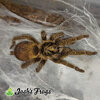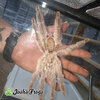- Joined
- Sep 17, 2009
- Messages
- 45
The Antilles Pink Toe Tarantula's scientific name, Caribena versicolor, translates as, "The Caribbean Spider that changes colors." Born sapphire blue with a distinct pattern, they gradually change to being metallic pink overall with a teal cephalothorax. Changes like these, that happen with age, are called ontogenetic changes.

Psalmopoeus victori is known as the Darth Maul Tarantula. It got that name from the striking, high contrast black and red that make this tarantula look so exciting. This individual is just starting to grow into its adult colors.


Psalmopoeus victori is known as the Darth Maul Tarantula. It got that name from the striking, high contrast black and red that make this tarantula look so exciting. This individual is just starting to grow into its adult colors.

Last edited:





















































